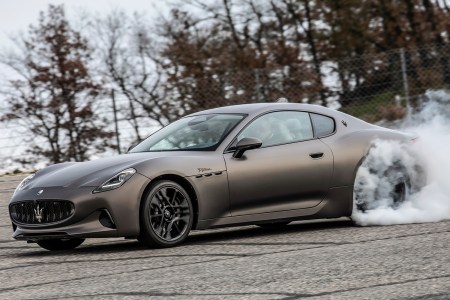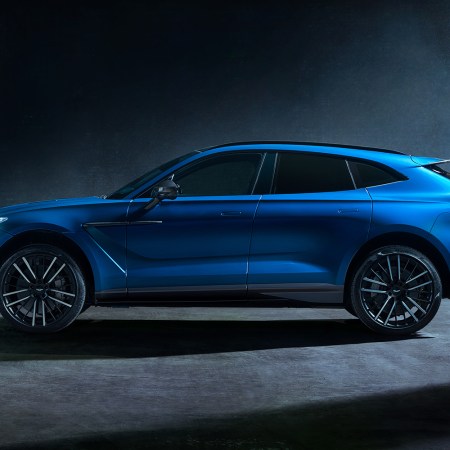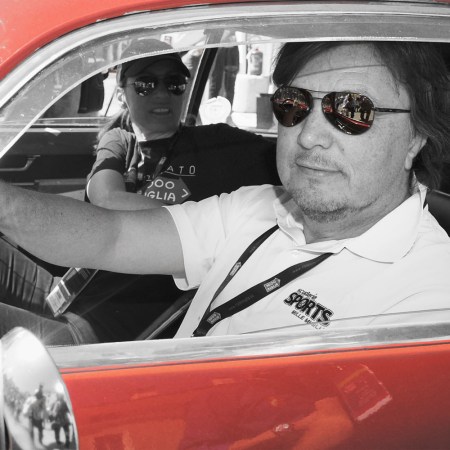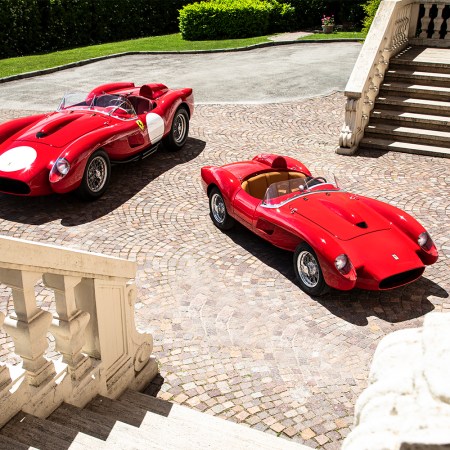A grand tourer is really just a sports car in a luxury wrapper. You get power and performance, of course, but in a package you could use as a daily driver and enjoy on a road trip. If we hop in our time machine, Maserati essentially invented this class of car 75 years ago with the 1947 A6 1500. Their latest version, the new 2024 GranTurismo, is every bit the chic luxury sports coupe we’ve come to expect.
Maserati is a quintessentially Italian brand, so where better to see how their newest creation performs than Italy? I spent a day cruising the autostrada and thrashing the pavement on the country roads north of Rome in both the Modena and Trofeo models (as well as the electric Folgore). The top line judgment is that the new GT, in all its forms, both remains an archetype of the class and modernizes the definition of the Italian grand tourer.

The Soul of Maserati
The GT is very much Maserati’s totem in terms of brand identity, so the recent redesign is one that they “had to get right,” according to Klaus Busse, the marque’s head of design. “There are very few brands that have this one brand defining car,” Busse says. “So there was the conscious decision not to destroy the icon, but to perfect the icon.” The exterior hasn’t changed much, and that was deliberate.
Though if you saw the previous version, which ended with the 2019 model year, parked next to the new GT, it would be plain that the 2024 model has gotten a wee bit swole, though it hasn’t quite taken up bodybuilding. The new GT is roughly five centimeters longer and four centimeters wider. The lines, while generally quite similar, have gotten a touch more muscular. Overall it still skews toward elegance rather than aggression.
Underneath the chic and subtle evolution of the exterior is where the real pursuit of perfection lies. For 2024, the GT comes in three powertrains, with the Modena and Trofeo models fitted with Maserati’s in-house Nettuno 3.0-liter twin-turbo V6, and one fully electric variant called the Folgore (Italian for lightning). (I reviewed the EV separately. Here I’m just talking about internal combustion, baby!)

Bigger Isn’t Always Better
V8 nostalgia is a bit like memories of an ex. The tears are gone, you’ve moved on and you’re better for it. But you can still remember the good times with a casual smile. The previous GT’s Ferrari-sourced engine was an absolute sonic head turner, even for people who knew nothing about cars. I’ll never forget the time that a woman who couldn’t tell a Quattroporte from quattro formaggi heard a GT rev to 6,000 rpm and exclaimed, “Ooooh, that’s sexy!” It sure was!
While it doesn’t sound nearly so nice, the Nettuno is a better engine. The V6 kicks out 483 hp in the Modena (which is priced starting at $174,000) and 542 hp in the Trofeo ($205,000 and up), thanks to bigger turbos. The best the old V8 could muster was 454 hp. And because power leads to speed, the new GTs get to 60 mph a full second faster than their predecessors: that’s 3.9 seconds in the Modena (443 lb-ft of torque) and 3.5 in the Trofeo (479 lb-ft).
Review: Can an Electric Maserati Outwit the Classic GranTurismo?
The ultimate test for the 2024 Folgore was pitting it against the new Modena and Trofeo on Italian roadsBeyond the power upgrade, the new platform uses a lightweight aluminum and steel hybrid construction, and features advanced adaptive air suspension. A double-wishbone front and multi-link rear suspension are both standard, as is torque vectoring. The Trofeo gets an upgraded electronically controlled limited-slip rear differential to the Modena’s mechanical one.
All-wheel drive is what you get in both GTs, but that hasn’t altered the ride height because both the engine and the eight-speed automatic gearbox sit behind the front axle. That configuration allows for a 52/48 weight balance.

Some Roads Lead to Rome
Whisking over country roads just north of Rome, diving into the bends and mashing the throttle on the exit, both GTs feel more like rear-wheel-drive monsters, though occasionally a good push on the gas will give you a glimmer of the front wheels’ pull.
However, there is a noticeable power difference between the two new models. The Trofeo offers more throttle response in general and utterly wicked acceleration when you slam the pedal to the floor for an overtake, but both versions are adroit and chock-full of Italian charisma in the corners. If you weren’t driving them both on the same day, you might not miss the extra 60 horses, but I did, and for the most part found myself more in tune with the Trofeo. Acceleration seemed more even and easy to finesse as I wound it up coming out of the twisty bits. But choosing between the two will be a highly personalized decision for any potential buyer.
The vented, big-boy Brembo brakes on both versions take very little work to get up to temperature, and once they sink their claws in, deceleration happens rapidly. Even shod in Pirelli P Zero Winter tires (it was rather cold on this Roman holiday), both the Modena and the Trofeo displayed ample grip. When temperatures rise, a set of summer rubbers on the 20-inch aluminum wheels in the front and 21-inchers in the back should let you choose lines with straight up impunity.
The Modena offers three driving modes, Comfort, GT and Sport, while the Trofeo adds a Corsa setting. Both cars allow the driver to decouple the stiffer suspension setting, which engages automatically in Sport and Corsa. It was a welcome feature on the autostrada where I found the ride a bit bubbly, perhaps thanks to those knobby winter tires, and with a push of a button the air suspension worked its magic.
For the majority of the day, I left both GTs in Sport mode, shifting with the steering column mounted paddles. In automatic, the computer seems to shift a bit early depending on your throttle angle.
The Corsa mode minimizes the effects of the traction control and stability systems. In other words, it’s not particularly advisable for public roads. If you just want to wag the tail a bit, the Sport setting is plenty. If you’re dead set on throwing the ass out and melting some rubber, Corsa will be your jam. But save it for a circuit, a closed road or at the bare minimum drives where you can see what’s coming a bit better than the back roads of Lazio where you’re likely to find slow moving farm equipment hogging the tarmac. For owners who do decide to take their Trofeo to the track, the traction and stability features can be turned off completely. Come si dice, “drift”?

But Bigger Is Sometimes Better
Maserati has fashioned a gorgeous environment to eat up long road trips. The overall design is clean, crisp and approaches a minimalist aesthetic. As you would expect, there is leather everywhere and the bolstered seats are posh without losing too much feel.
A new central touchscreen infotainment system is front and center, and mostly easy and intuitive. The instrument cluster also gets the digital treatment, which has been positioned lower so the diver can better read the tops of the speedometer and tachometer. Specifically for the person behind the wheel, Maserati has integrated a standard head-up display and their Active Driving Assist, which includes adaptive cruise control and lane-keeping assist, plus my new favorite feature, speed camera alert! Ciao, Carabinieri!
The standard 14-speaker Sonus Faber Premium Audio system and optional 19-speaker variant are both aurally and visually reminiscent of the top-notch Burmester systems you find as add-ons in the Mercedes-Benz lineup.
Okay, enough gushing. My only substantial gripe relates to the buttons you use to put the car into drive, reverse and manual. They are, if I’m being generous, clunky, and sometimes I had to push them a couple of times to get my selection to engage. A more minimal complaint: the motor that opens the glovebox yields a noise that sounds like it’s broken, and you have to close it manually. It’s a flourish of over-engineering that doesn’t beat an old-fashioned latch.
The 2+2 configuration in a grand tourer is typically big enough for a couple of overnight bags, and maybe two very small children. These new GTs are a bit more spacious and can accommodate a pair of adults in the rear, thanks to a bit of creative interior design and an automatic shift of driver and front passenger positions. When the car senses a passenger has hopped in the back, it moves the front buckets forward to add room in the rear, a smart bit of tech. But I used the word “can” here because I don’t know any fully grown humans who would want to squeeze into the back without losing a coin toss first. I climbed in during a preview last year, and while I did fit, it wasn’t a place I wanted to spend much time. Splitting the legroom difference between the front and the rear also moves the driver into a less than ideal posture, with knees essentially touching the steering column. Perhaps the +2 will feel a little less claustrophobic when Maserati launches a cabriolet in the medium term.
Both the Modena and Trofeo are currently available for order with deliveries beginning in the second quarter of 2023. Those keen on buying an electric Folgore will need to exercise some patience as they aren’t yet available for order and probably won’t make their way to customers until the beginning of 2024.
Maserati understood the assignment when redesigning the GranTurismo, and they aced it. The new gas-powered GTs are speedy, deft, ultra-luxury coupes, ready to not only devour long stretches but compete in the rarified air of the grand touring segment. But with nearly 80 years of heritage and history, did anyone actually expect them to fail?
This article was featured in the InsideHook newsletter. Sign up now.






















